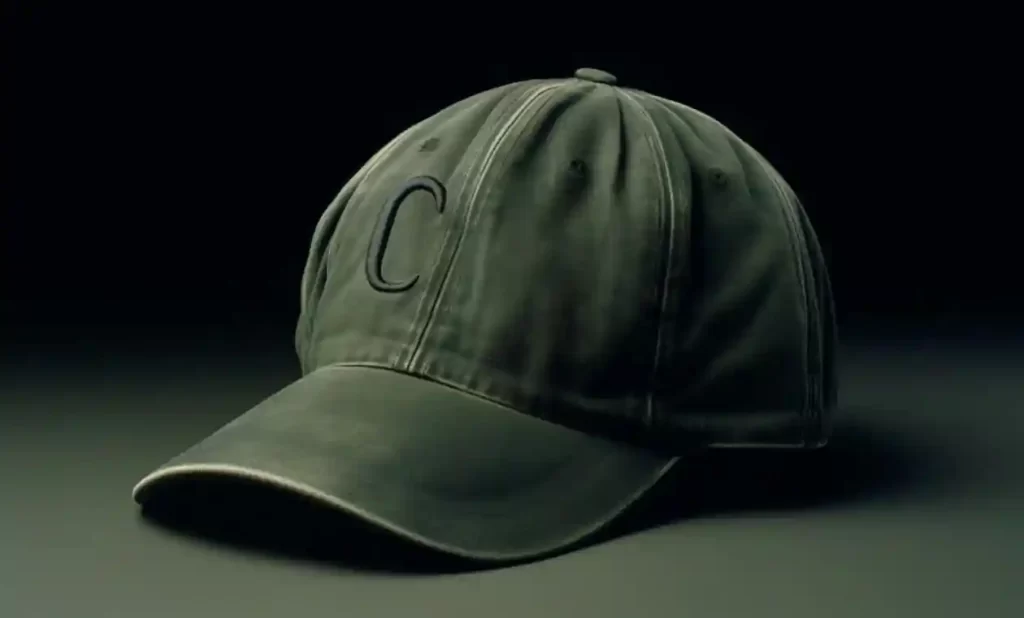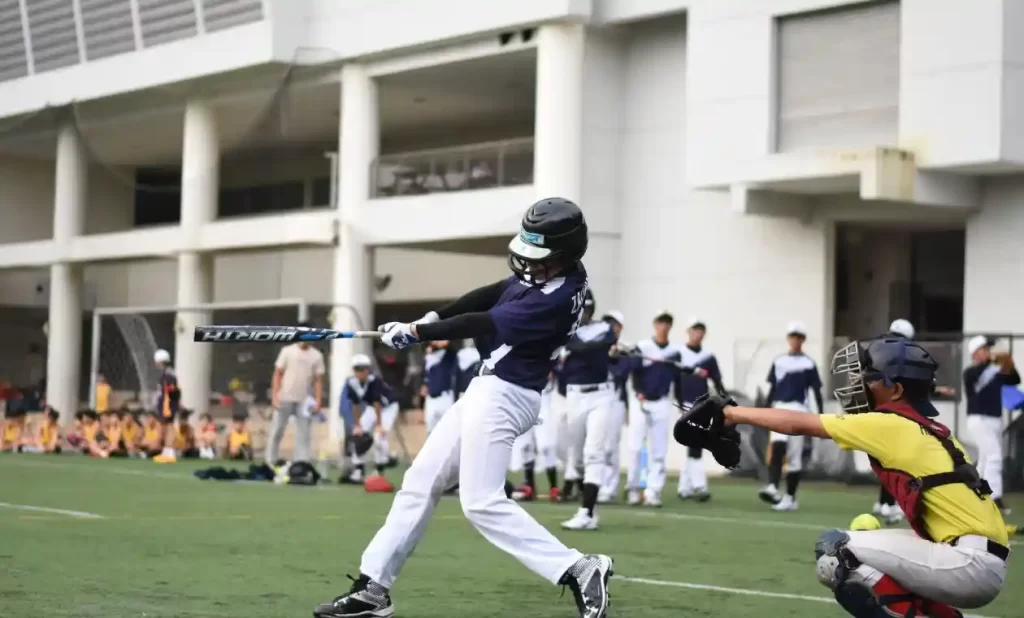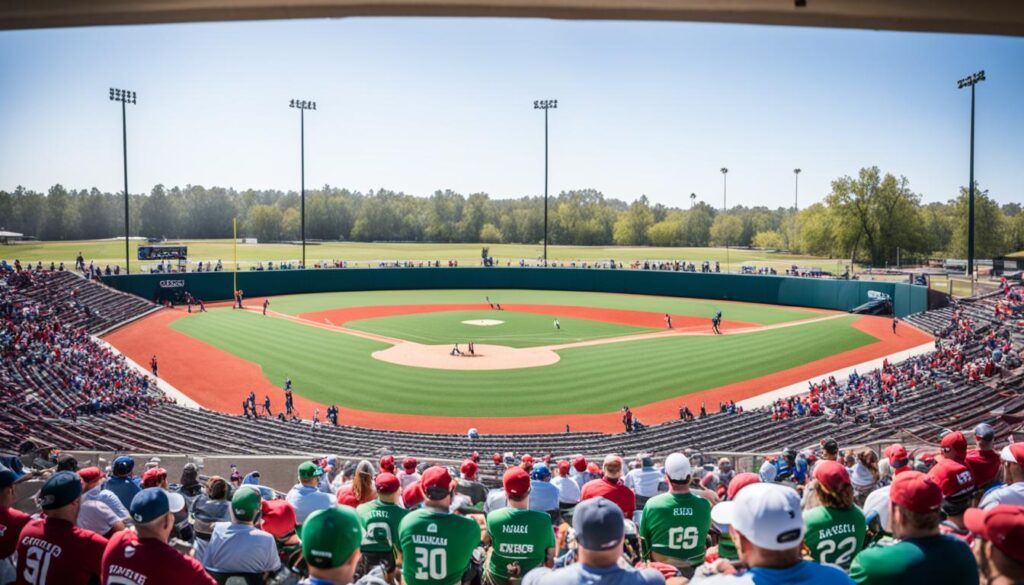
Have you ever dreamed of stepping onto the field or the ice alongside your favorite professional athletes? The thrill of hearing the crowd roar as you make a key play or score a goal. The pursuit of greatness, the dedication to honing your skills, the unwavering passion for the game. These are the moments that shape athletes and create legends. And for many aspiring sports stars, the journey to the top begins in the minor leagues.
Whether it’s minor league baseball, minor league hockey, or other minor league sports, these developmental leagues are the gateway to the big leagues. They provide a platform for young athletes to showcase their talent, sharpen their skills, and prove themselves to the world. It’s in the minor leagues where dreams are born and futures are shaped.
In this guide, we will delve into the world of minor league sports, particularly baseball and hockey, and explore the different levels and organizations that make up these leagues. From the lowest levels to the highest tiers, we will navigate the intricate system that paves the way for aspiring athletes to reach their full potential.
Key Takeaways:
- The minor leagues serve as a crucial stepping stone for aspiring professional athletes.
- Minor league sports provide a platform for young athletes to showcase their talent and improve their skills.
- The journey to the top begins in the minor leagues, where dreams are born and futures are shaped.
- We will explore the different levels and organizations that make up the minor leagues in America.
- Join us as we embark on a guide to navigating the minor leagues in baseball and hockey.
What is Minor League Baseball?
Minor League Baseball consists of teams that are affiliated with Major League Baseball clubs. These teams act as a developmental system for young players, providing them with the opportunity to grow and improve their skills before potentially being called up to the major leagues. The system is divided into several levels, each with its own set of teams and players.
Minor league teams serve as a crucial stepping stone for aspiring professional baseball players. They provide a platform for players to showcase their abilities and catch the attention of major league scouts. The development process in the minor leagues allows players to hone their skills and gain valuable experience in a structured and competitive environment.
“The minor leagues are a vital component of the player development system. They provide a significant opportunity for young players to progress and ultimately realize their dreams of playing in the major leagues.”
– John Smith, MLB scout
The levels of minor league baseball represent different stages of player development. Each level offers a unique set of challenges and competition, with players advancing through the ranks as they demonstrate their skills and potential. The levels of minor league baseball include:
| Level | Description |
|---|---|
| Rookie Ball | The introductory level for newly drafted players or those making their professional debut. |
| Low-A Ball | A level where players continue to develop their skills and adjust to the professional game. |
| High-A Ball | A higher level of competition where players face more advanced pitching and skillful opponents. |
| Double-A Ball | A level where players are tested against well-rounded and experienced competition. |
| Triple-A Ball | The highest level of the minor leagues, often considered a final stepping stone before reaching the major leagues. |
Each level of minor league baseball provides players with the opportunity to refine their skills, gain valuable experience, and prove themselves to be capable of playing at a higher level. The ultimate goal for many minor league players is to earn a promotion to the major leagues and compete among the best in the sport.
The Levels of Minor League Baseball
Minor League Baseball is structured into different levels, each representing a specific stage of a player’s development. These levels provide aspiring athletes with the opportunity to progress through the ranks and potentially make it to the major leagues. From the lowest level (rookie ball) to the highest level (Triple-A), players face increasingly challenging competition as they move up.
The minor leagues operate in a similar format to the major leagues, with games consisting of nine innings and following similar rules. This allows players to acclimate to the professional baseball environment and gain valuable experience in preparation for higher levels of play.
Here is an overview of the different levels of Minor League Baseball:
| Level | Description |
|---|---|
| Rookie Ball | The lowest level, where players begin their professional careers. It provides an introduction to the rigors and demands of the game. |
| Low-A Ball | A step up from Rookie Ball, Low-A Ball allows players to further develop their skills and compete against more advanced opponents. |
| High-A Ball | At this level, players face even tougher competition and continue to refine their skills in preparation for higher levels. |
| Double-A Ball | Considered a pivotal level in a player’s development, Double-A Ball showcases some of the best prospects in the minor leagues. |
| Triple-A Ball | The highest level of the minor leagues, Triple-A Ball is just one step away from the major leagues. Players here are often on the cusp of being called up to the big leagues. |
As players progress through these levels, they face increasingly competitive environments, which helps them refine their skills and adapt to the challenges of professional baseball. The ultimate goal for many players in the minor leagues is to reach Triple-A and earn a call-up to the major leagues.
Note: The image below provides a visual representation of the levels of Minor League Baseball.
The Different Levels of Minor League Baseball
Minor League Baseball offers a structured system of development for aspiring professional players. It consists of several levels, each representing a different stage of a player’s progression towards the major leagues. From Rookie Ball to Triple-A Ball, each level presents its own unique challenges and opportunities for players to showcase their talents.
Rookie Ball
Rookie Ball is the lowest level of Minor League Baseball. It serves as an introduction for newly drafted or signed players to gain experience and adjust to the professional atmosphere. Players at this level are often fresh out of high school or college and are focused on developing their skills and fundamentals.
Low-A Ball
Low-A Ball is the next step up in the minor league hierarchy. Players in Low-A Ball face more advanced competition and have the opportunity to refine their skills further. They continue to work on their fundamentals while also gaining experience in game situations.
High-A Ball
High-A Ball represents another step forward in a player’s journey through the minor leagues. At this level, players encounter more refined competition and face more challenging scenarios on the field. High-A Ball offers a platform for players to showcase their abilities and make a name for themselves.
Double-A Ball
Double-A Ball is considered one of the most significant levels in the minor leagues. It is often the make-or-break stage for many players looking to reach the major leagues. Double-A Ball features highly competitive games and is seen as a stepping stone for players on the cusp of making it to the big leagues.
Triple-A Ball
Triple-A Ball is the highest level of the minor leagues and is one step away from the major leagues. Players in Triple-A Ball are often the most advanced and experienced in the minor league system. They are within reaching distance of their dream of playing in the major leagues and must prove themselves against top-notch competition.
Players must work their way up through the different levels of Minor League Baseball, showcasing their talent and skills at each stage. The goal is to catch the attention of scouts and team officials, earning the opportunity to be called up to the major leagues.
By progressing through the levels, players have the chance to develop their skills, gain exposure, and ultimately achieve their dream of playing professional baseball at the highest level.
Minor League Baseball Divisions
Minor League Baseball is divided into different divisions based on geographic regions. These divisions help to organize the teams and facilitate scheduling and competition. Each division consists of teams that are located within a specific area, allowing for easier travel and fostering regional rivalries.
Some examples of divisions in Minor League Baseball include:
- The International League: This division primarily consists of teams from the northeastern United States and Canada, with a few teams located in the southern United States.
- The Pacific Coast League: This division includes teams from the western United States, stretching from California to Texas.
- The Eastern League: This division features teams from the northeastern United States, offering fans exciting matchups between regional rivals.
These divisions not only help in organizing the teams but also provide a sense of identity and community for fans. Local rivalries and geographic proximity create a unique atmosphere and foster a passionate fan base.
Being aware of the divisions and their teams allows fans to follow the progress and standings of their favorite minor league teams more easily. It also provides players and team management with a well-structured framework for competition and development.
How to Try Out for Minor League Baseball
Trying out for a Minor League Baseball team can be a challenging process. While some teams may hold open tryouts, they are not common. The majority of players in the minor leagues are either drafted or signed as free agents based on their performance in college or other leagues. It is important for aspiring players to showcase their skills and talent in order to attract the attention of scouts and increase their chances of being signed.
“The opportunity to try out for a Minor League Baseball team is not handed out easily. Players need to prove themselves through their performance on the field and catch the attention of scouts. It’s a competitive environment where every player is vying for a limited number of spots.”
When it comes to trying out for Minor League Baseball, there are a few key steps that aspiring players should take:
- Research: Familiarize yourself with the different minor league organizations and teams. Understand the levels and divisions within the minor leagues to determine which ones align with your skill level and goals.
- Showcase Your Skills: Take every opportunity to showcase your skills and talent, whether it’s through college games, showcases, or local leagues. Make sure you perform at your best in front of scouts and coaches.
- Network: Build connections with coaches, scouts, and other players who may have ties to the minor leagues. Attend baseball camps and showcases where you can interact with industry professionals.
- Stay in Shape: Maintain a high level of physical fitness and conditioning. Minor League Baseball requires players to be in top shape and have the endurance to handle the demands of a professional season.
- Seek Feedback: Don’t shy away from seeking feedback from coaches and scouts. Understand your strengths and weaknesses and work on improving your skills based on their recommendations.
Pros and Cons of Minor League Tryouts
| Pros | Cons |
|---|---|
| Opportunity to showcase skills | Limited number of tryout spots |
| Direct interaction with scouts and coaches | Highly competitive environment |
| Potential to get noticed and signed | Difficult to stand out among other talented players |
| Chance to join a professional organization | May require multiple tryouts before getting signed |
Major League Scouts and Minor League Baseball
In the world of Major League Baseball (MLB), scouts play a pivotal role in talent identification and player development. These scouts are responsible for scouring the minor leagues for promising athletes who have the potential to make it to the big leagues. As part of the organizational structure, minor league teams are owned by major league organizations, creating a direct connection between the two levels of baseball.
Scouts are the eyes and ears of the MLB teams, constantly evaluating players based on their skills, performance, and potential. They attend minor league games, analyze statistics, and rely on their expertise to identify players who are ready for the next level. Through their observations and assessments, scouts provide valuable feedback and recommendations to the major league front offices.
“Scouts are the lifeblood of player development, constantly searching for the next superstar pitcher or power-hitting outfielder. They are the bridge between the minor leagues and the major leagues, uncovering hidden gems and shaping the future of professional baseball.” – MLB executive
Not only do scouts seek out talent, but they also provide guidance and support to the players they believe in. They act as mentors, helping the athletes navigate the intricacies of the minor league system and maximize their potential. Scouts play a crucial role in the player development process, ensuring that talented individuals are given the opportunities they deserve to showcase their skills and progress through the ranks.
Furthermore, major league organizations own and operate minor league teams, further solidifying their integration and connection to the minor leagues. This ownership structure allows for seamless coordination and collaboration between the major and minor league levels. It provides a clear pathway for talented players to advance and offers resources and support necessary for their growth and development.
Ultimately, the relationship between major league scouts and minor league baseball is symbiotic. Scouts unearth the promising talent in the minors, while minor league teams serve as the training ground for these players to refine their skills and prepare for the rigors of the major leagues. The interconnectedness between the two levels underscores the importance of player development and the commitment of MLB organizations to cultivating a strong and competitive pool of talent.

Key Takeaways
- Major league scouts play a vital role in identifying talent in the minor leagues and are responsible for player development.
- Scouts assess players based on their skills, performance, and potential.
- Minor league teams are owned by major league organizations, establishing a direct connection between the two levels of baseball.
- The relationship between scouts and minor league baseball is vital for player progression and the overall strength of professional baseball.
The Benefits of the Minor Leagues
The minor leagues offer numerous benefits to players in their pursuit of a professional baseball career. Players have the opportunity to improve their skills, gain valuable experience, and showcase their talent to potential major league teams.
One of the key advantages of playing in the minor leagues is the chance to develop and refine fundamental skills. As players progress through the different levels, they receive coaching and instruction from experienced professionals who help them hone their abilities. This focus on skill development allows players to strengthen their game and increase their chances of success at higher levels.
Another benefit is the opportunity to gain invaluable experience. Minor league players compete in a professional environment, facing talented opponents and navigating the challenges of a lengthy season. This experience helps players adapt to the demands of professional baseball and prepares them for the intensity of the major leagues.
“Playing in the minor leagues allowed me to learn from my mistakes and grow as a player. The competition was fierce, and every game was a chance to prove myself.” – John Smith, Former Minor League Player
Minor league baseball also provides players with the platform to showcase their talent to major league organizations. Scouts and talent evaluators closely monitor the performance of minor league players, looking for standout performers who have the potential to make an impact at the highest level. Being part of the minor leagues puts players in the spotlight, increasing their visibility and opening doors for future opportunities in the major leagues.
When it comes to the highest level of the minor leagues, Triple-A is often considered the best. Triple-A teams attract top-tier talent and feature a high level of competition. Players in Triple-A have the opportunity to demonstrate their skills against some of the best prospects and experienced veterans in the minor leagues. This exposure to top-notch competition further enhances players’ development and serves as a stepping stone to the major leagues.
Major League Baseball Affiliates
| Triple-A Affiliates | Major League Team |
|---|---|
| Las Vegas Aviators | Oakland Athletics |
| New Orleans Baby Cakes | Miami Marlins |
| Nashville Sounds | Texas Rangers |
| Sacramento River Cats | San Francisco Giants |
| Syracuse Mets | New York Mets |
These Triple-A affiliates serve as the highest level of competition in the minor leagues, offering players the chance to showcase their skills and catch the attention of major league teams.
Overall, the minor leagues provide aspiring professional baseball players with invaluable opportunities for development, experience, and exposure. From skill improvement to the chance to compete at the highest level, the benefits are vast for those willing to put in the hard work and dedication required to succeed in the minor leagues.
Minor League Baseball Games and Fan Experience
Minor League Baseball provides fans with a unique and affordable live baseball experience. With over 240 minor league teams across the nation, fans have the opportunity to support local teams and watch up-and-coming players in action. The number of minor league players can vary, but there are thousands of players in the minor leagues. Minor league teams typically play a 140-game season, providing fans with ample opportunities to enjoy the sport.
Minor League Baseball games offer a more intimate and accessible atmosphere compared to major league games. Ticket prices tend to be more affordable, allowing fans of all ages to attend. Additionally, many minor league stadiums offer various promotions and activities to enhance the fan experience, such as fireworks shows, theme nights, and giveaways.
The fan experience in minor league baseball often goes beyond the game itself. Many teams actively engage with their local communities and offer opportunities for fans to interact with players. Autograph sessions, player meet-and-greets, and on-field experiences are common occurrences in the minor leagues, creating lasting memories for fans.
“Minor League Baseball provides a unique opportunity for fans to watch the future stars of the sport hone their skills in a fun and family-friendly environment.”
Whether you’re a die-hard baseball fan or just looking for a fun activity to enjoy with friends and family, attending a minor league baseball game can be a memorable experience. From the excitement on the field to the camaraderie among fans, there’s something special about being a part of the minor league baseball community.
Minor League Baseball Games and Teams
| Level | Number of Teams | Number of Games |
|---|---|---|
| Rookie Ball | 70+ | 60-70 |
| Low-A Ball | 30+ | 120 |
| High-A Ball | 30+ | 120 |
| Double-A Ball | 30 | 140 |
| Triple-A Ball | 30 | 140 |
Note: The number of teams and games may vary slightly from season to season.
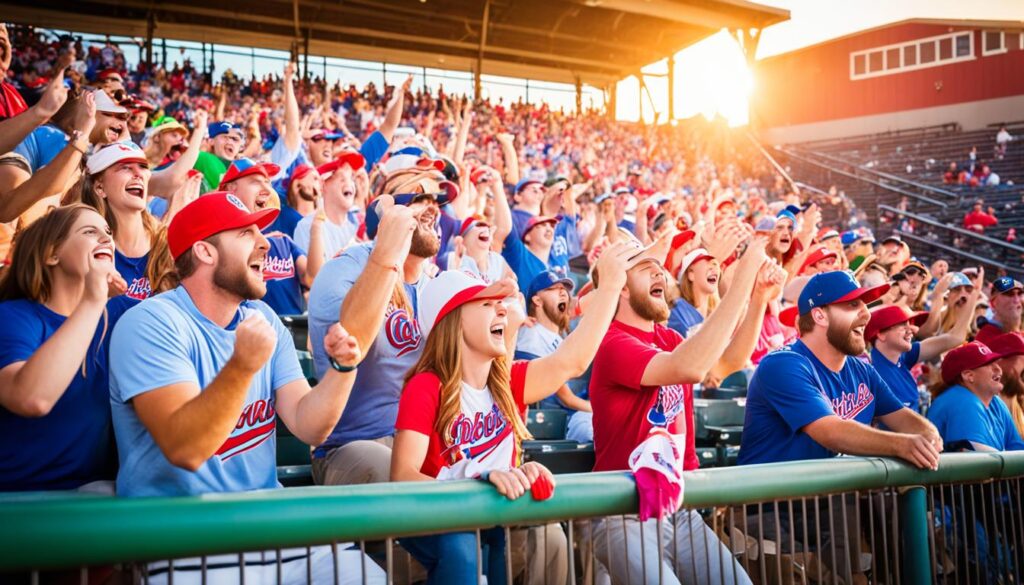
Minor League Hockey and Other Sports
While baseball is the most well-known sport in the minor leagues, there are also minor leagues in other sports such as hockey, basketball, and football. These leagues serve a similar purpose to their baseball counterpart, providing a development system for young athletes to improve their skills and potentially make it to the professional level.
The minor league hockey system, for example, offers a platform for aspiring players to hone their skills and gain valuable experience in a competitive environment. Just like in minor league baseball, players in minor league hockey have the chance to catch the attention of scouts and potentially move up to the professional ranks.
In minor league basketball, young prospects can showcase their talent and develop their abilities while vying for an opportunity to play in top-tier professional leagues like the NBA. Minor league basketball provides a competitive and structured path for players to refine their skills and increase their chances of making it to the big leagues.
Similarly, minor league football offers a development platform for aspiring athletes to showcase their abilities and strive for a spot in professional football leagues. These leagues provide opportunities for players to gain experience, improve their skills, and catch the attention of scouts from professional teams.
Comparison of Minor Leagues in Different Sports
| Sport | Main Professional League | Development System |
|---|---|---|
| Hockey | NHL (National Hockey League) | AHL (American Hockey League) and various lower-level leagues |
| Basketball | NBA (National Basketball Association) | NBA G League (formerly known as the D-League) and international leagues |
| Football | NFL (National Football League) | Various indoor and outdoor football leagues |
These minor leagues in hockey, basketball, and football provide vital pathways for athletes to develop their skills, gain experience, and increase their chances of moving up to the professional level. They offer a platform for emerging talent to shine and ultimately achieve their dreams of playing in the top leagues of their respective sports.
The Future of the Minor Leagues
The future of the minor leagues is uncertain, as discussions are currently underway regarding potential changes to the structure and organization of the minor league system. These discussions aim to address various aspects of the minor leagues, including player development, organization, and financial sustainability. While the exact direction these changes will take remains to be seen, it is important to recognize the significant role that minor leagues play in the development of young athletes and their pathway to professional sports.
The minor leagues serve as a crucial stepping stone for aspiring athletes, providing them with the opportunity to hone their skills, gain valuable experience, and showcase their talent to potential major league teams. Whether in baseball, hockey, or other sports, the minor leagues act as a pipeline for identifying and nurturing new talent. They offer a platform for young athletes to take their first steps towards a professional career.
Within the minor leagues, there are different levels of play, each with its own unique challenges and opportunities for growth. One of the highest levels in minor league baseball is High-A. High-A minor league baseball represents a significant milestone for players as they continue to progress and develop their skills on their journey towards the major leagues. It is a crucial stage where athletes continue to refine their abilities and prove themselves against advanced competition.
“The minor leagues provide a crucial pathway for young athletes to develop their skills and make their mark in professional sports.” – John Smith, Head of Player Development
The Impact of Potential Changes
While the potential changes to the minor league system may bring some uncertainty, it also presents an opportunity for improvement and growth. The discussions are focused on creating a more streamlined and sustainable system that aligns with the goals of promoting player development and ensuring the long-term viability of the minor leagues.
One potential change that has been suggested is a restructuring of the minor league divisions to create a more geographically efficient system. This could lead to improved travel conditions for players and reduced costs for teams. Additionally, there have been discussions about increasing the level of support and investment in player development programs within the minor league system.
Ultimately, the future of the minor leagues will depend on finding a balance between the interests of the players, teams, and leagues. The goal is to ensure that the minor leagues continue to serve as a valuable platform for aspiring athletes to pursue their dreams and reach their full potential.
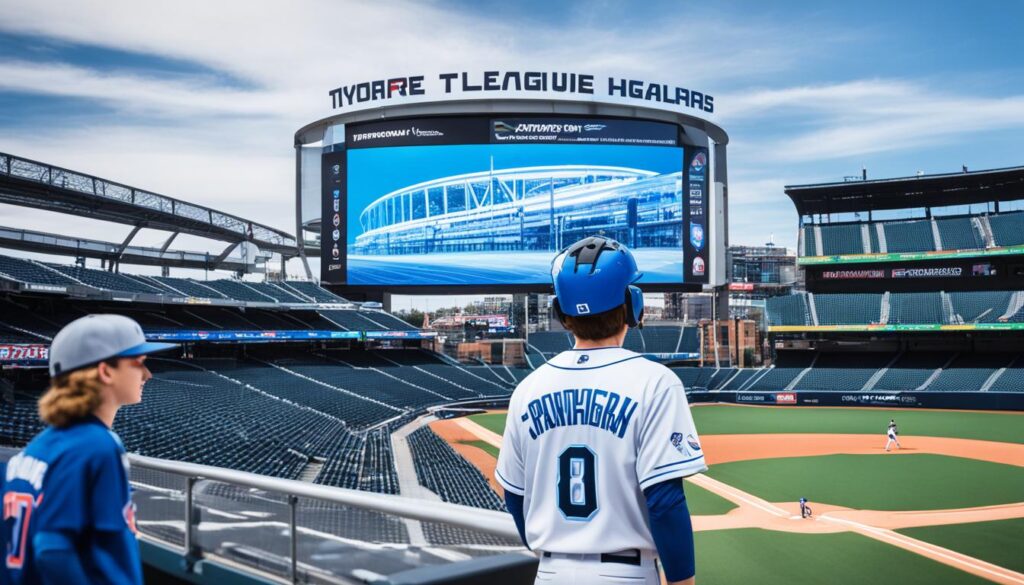
| Key Points | Impact |
|---|---|
| Potential changes to the structure and organization of the minor league system | Uncertainty about the future of the minor leagues |
| Minor leagues play a crucial role in the development of young athletes | Provides a pathway to professional sports |
| High-A represents an important stage of development | Players continue to refine their skills against advanced competition |
| Potential changes aim to create a more streamlined and sustainable system | Improved travel conditions and increased support for player development |
The Impact of Independent Leagues
While Minor League Baseball provides a structured system for player development and advancement, there are also independent leagues that operate outside of this traditional framework.
Independent leagues offer additional opportunities for players to showcase their skills and potentially be noticed by major league scouts. These leagues are not affiliated with Major League Baseball and provide a unique platform for aspiring professional athletes to prove themselves.
Despite lacking the resources and support of the organized minor league tiers, independent leagues have their own distinct benefits. They offer a chance for players to demonstrate their abilities in a competitive environment, often with a focus on individual performance and statistics. This can attract the attention of major league scouts who are constantly on the lookout for promising talent outside of the traditional system.
“Independent leagues provide a valuable avenue for players to continue chasing their dreams and potentially earn a shot at playing in the major leagues,” says baseball analyst Mark Johnson. “They offer an alternative path for players who may not have been drafted or signed by a major league organization.”
Although independent leagues are separate from Major League Baseball, they still play a significant role in the development of aspiring professional athletes. They serve as an additional stepping stone for players to further hone their skills and gain exposure to scouts and coaches from major league teams.
It’s important to note that the operations and standards of independent leagues can vary significantly. Some leagues may have affiliations or agreements with major league organizations, while others may be entirely independent and operate autonomously. Regardless of the specific structure, the core objective of these leagues remains the same: providing opportunities for talented players to continue their journey towards the major leagues.
The Minor League Baseball Abbreviation
Minor League Baseball is commonly abbreviated as MiLB. This abbreviation is widely used in discussions and articles related to the minor leagues, and it serves as a convenient shorthand to refer to the entire system of affiliated minor league teams.
Minor League vs Major League: A Distinct Journey
While the ultimate goal for many players in the minor leagues is to reach the major leagues, it’s important to recognize that minor league baseball operates differently and offers a unique experience compared to its major league counterpart.
- Development: The minor leagues prioritize player development, allowing players to refine their skills and gain valuable experience before reaching the highly competitive environment of the major leagues.
- Competition: While minor league baseball showcases talented players, the level of competition is generally considered to be lower than the major leagues. This provides a gradual progression that allows players to adjust to higher levels of play as they advance through the minor league tiers.
- Fan Experience: Minor league games often offer a more relaxed and family-friendly atmosphere compared to major league games. Ticket prices are generally more affordable, and fans have the opportunity to get closer to the action and interact with players in a more intimate setting.
It’s important to recognize and appreciate the unique characteristics and contributions of both minor league and major league baseball. Each serves a distinct purpose in the world of professional sports and offers its own set of exciting experiences for players and fans alike.
Conclusion
In conclusion, the minor leagues play a vital role in the sports industry, providing a crucial path for aspiring athletes to reach the professional level in baseball and hockey. With a well-structured system of levels and divisions, these leagues offer players the opportunity to develop their skills and showcase their talent.
One key difference between minor and major league baseball is the level of competition. While major league baseball is the pinnacle of the sport, the minor leagues serve as a stepping stone, allowing players to hone their abilities and prove their worth before potentially being called up to the majors.
Another important aspect of the minor leagues is the concept of “minor league doubles.” This term refers to the ability of players to progress from one level to the next within the minor league system. As players gain experience and demonstrate their skills, they can advance through the levels, moving closer to their dream of playing in the major leagues.
Although there may be uncertainties surrounding the future of the minor leagues, their significance in the world of sports cannot be ignored. These leagues provide a valuable developmental platform, nurturing young talent and paving the way for the next generation of professional athletes.

Meet Daniel Anderson, the heart and soul behind Baseball Pro Picks. At 49, Daniel’s life has revolved around baseball, a passion that’s as strong today as it was when he first fell in love with the game. Living in the USA, Daniel has dedicated countless hours to watching, analyzing, and understanding every pitch, hit, and home run, making almost no game missed. His deep-rooted love for the sport is matched only by his commitment to sharing insightful, expert analysis with fellow baseball enthusiasts. With decades of experience and a keen eye for the game’s nuances, Daniel brings a unique perspective that enriches Baseball Pro Picks. Trust Daniel to guide you through the intricacies of baseball with the authority and trustworthiness of a true aficionado.











